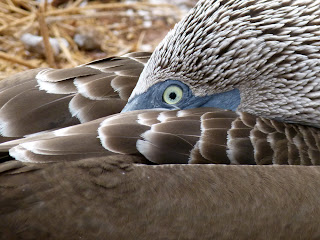In Florida, where I am most familiar with sea birds, there will be several species of gulls and terns soaring along the coast for me to learn, diving for fish. Here the Blue-footed and Nazca Boobies are much easier to identify. Yes, there are also Red-footed and Brown Boobies, but we didn't go to the islands where they live. These birds spend the day soaring overhead looking for fish. The bird itself is 32-34 inches long (about the size of a goose), with a long curved neck, and they can live as long as 17 years.
When it spies a likely target, those five foot long wings fold and it dives straight down with with a splash. In a moment, though, it pops back to the surface like a cork.
The blue feet are the most eye catching feature, of course. Males are proud of their bright feet, and dance in a high stepping strut to show them off to a prospective mate. She thinks the color is important too, and tends to choose the brightest blue male.
The eyes are the key to identifying males and females. The male has a small pinpoint iris, while the female's iris is larger and almost star-shaped.
Nest building is a simple process. Just choose an empty spot and start laying eggs! The hiker's trail makes a good spot for many Boobies, and you have to watch for them when walking through the nesting area on North Seymour Island. Just in case you aren't sure, the nest is in the middle of a "ring of poop!" As the female sits on the eggs, she simply shoots the poop out around her spot. The Blue-footed Booby lacks "brooding patches" of skin to keep the eggs warm, so instead it uses its feet to incubate them. Despite their blue appearance, the feet have an excellent blood supply.
According to the experts, they can lay 1-3 eggs, but we only saw one chick with another unhatched egg.
Finally added up the totals of birds seen on this trip. Altogether, both in the islands and mainland Ecuador, we saw 72 species, 54 of which were life birds! Our leader Kevin, saw more, of course, but I didn't include any we didn't actually see ourselves. Pretty good, isn't it?








1 comment:
Blue-footed Boobies, what amazing looking birds, great images and the video is also great. I can only imagine how thrilling your time with them was, just an outstanding adventure for you, or anyone!!!
Post a Comment